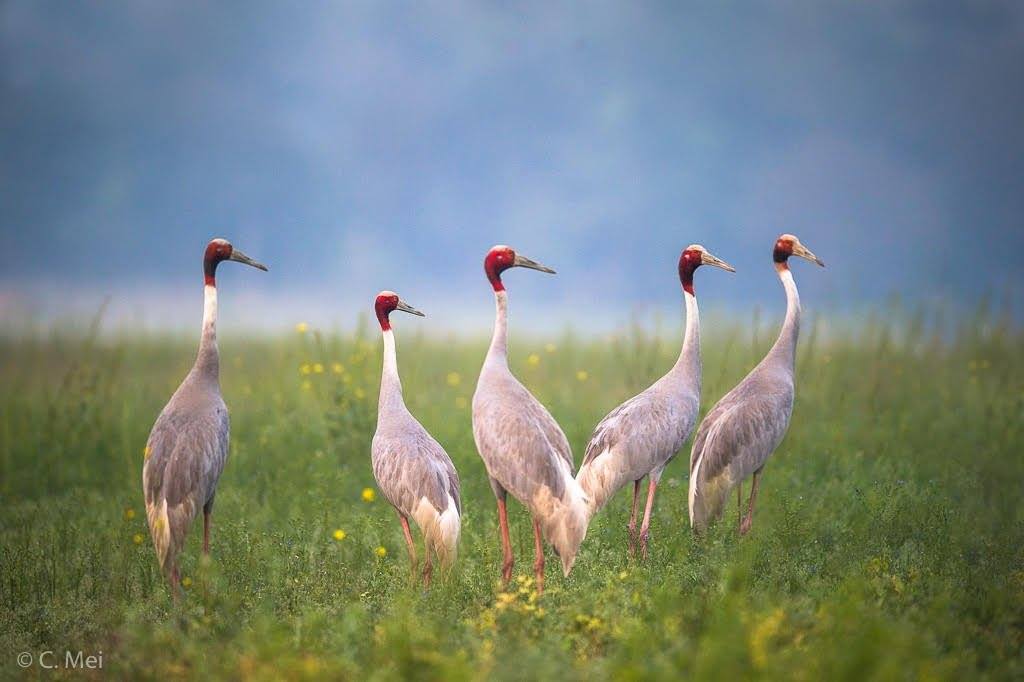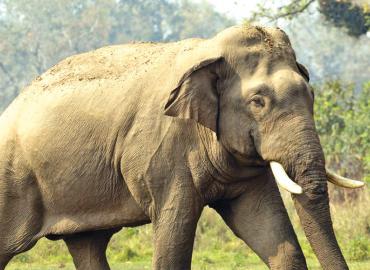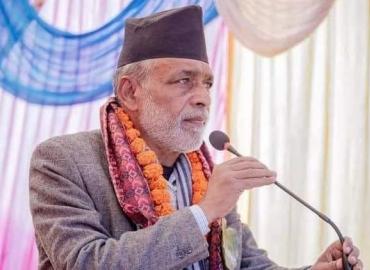Raju Jhallu Prasad
Kathmandu: A research program titled “The Status of Sarus Crane in Nepal” was concluded on Friday. The program, jointly organized by the Nepal Geological Society and the Central Department of Zoology, Tribhuvan University, with financial support from WWF Nepal and the International Crane Foundation, conducted a comprehensive study on the distribution, population, and habitat of the Sarus Crane and made its findings public.
Dr. Hari Prasad Sharma, Professor at the Central Department of Zoology, Tribhuvan University, and Dr. Bishnu Prasad Bhattarai, Assistant Professor and Conservation Biologist at the Central Department of Zoology, along with Dr. Hem Bahadur Katuwal, an active researcher in bird and wildlife conservation in Nepal since 2010, were part of the study and survey team. The research team also conducted orientation programs for Saras conservation in schools and among local communities in Lumbini.
According to Katuwal, the study has encountered a total of 690 rare Saras Cranes in Nepal. Among them, 652 were found in the vast Lumbini region (200 in Kapilvastu, 382 in Rupandehi, and 70 in Parasi), 33 in Banke and 5 in Kanchanpur. The survey was conducted in 5 protected areas and 10 sites of bird and biodiversity conservation, utilizing both systematic and opportunistic survey methods, resulting in such findings.

“Until now, the data on Sarus Crane was uncertain. Although previous studies estimated the population to be between 400 to 700 individuals. Still, a comprehensive study was deemed necessary,” said Katuwal. During the last April and May (pre-breeding season), a team of researchers conducted a large-scale systematic survey covering 113 locations across Nepal (only 93 in the Lumbini region), within 5-5 kilometer grids. “28 teams surveyed 382 Sarus Cranes in Rupandehi, 70 in Parsa, and 200 in Kapilvastu, while another team recorded 33 individuals in Banke,” he further added.
Rajendra N Suwal, Crane Ecoloist, Head of Partnership Development,WWF Nepal, has provided information on the status, development, and cultural significance of Saras (cranes) in Nepal, along with promoting sustainable tourism.
According to him, the status of Saras in Nepal is of great concern, as these beautiful birds are facing various threats to their survival. Habitat loss due to human activities, pollution, and disturbances in their breeding grounds are some of the major challenges Saras are encountering. Conservation efforts are essential to protect these species from further decline.
Regarding development, Rajendra Suwal emphasizes the need for balanced development that takes into account wildlife conservation. Sustainable development practices that consider the ecological impact are vital to ensure the coexistence of wildlife and human activities.
According to another researcher, Bhattarai, a special survey on Sarus Crane was conducted in various 11 locations: Jagadishpur artificial lake and Bajahat Tal in Kapilvastu, Vishnupura, Gaindahawa Tal, Khadaiya Ita Bhata, Duimuhan, Majhgaun, Aurahi Purba, Babai Durga Mandir, Aazamghat, Nandan Tal in Parsa, and Bhagwanpur area in Banke.

“Out of the 10 districts surveyed from Chitwan to Kanchanpur (covering 70% of the Chure region), 5 districts have confirmed the presence of Sarus Cranes in the sensitive list of Schedule 2 and IUCN Red Book,” the researcher stated. However, during this study, Sarus Cranes were not found in the Puraniya Tal in Kailali and Bardia Tal. In other districts as well, Sarus Cranes were not sighted during this period.
More than 400 discussions were conducted with local communities during the study, and everyone recognized the presence of Sarus Cranes. The locals considered the presence of Sarus Cranes as a positive sign for rice cultivation. “The presence of Sarus Cranes indicates good rice cultivation,” the researcher added.
The belief was prevalent that Sarus Cranes live in the Simsaar area. However, recent research has shown that they prefer larger cultivated areas for breeding. “Around 4.5% of Nepal’s total area (6,659 square kilometers) is found suitable for Sarus Cranes,” the researcher explained.
According to Bhattarai, the study team has made efforts to understand not only the population of Sarus Cranes but also their geographical distribution and habitat conservation challenges, as well as the relationship between Sarus Cranes and human settlements and the local communities’ perception of Sarus Crane conservation. The study was conducted during the months of April and May, and now they feel the need for further research during the monsoon season (breeding season) to gain more insights. Bhattarai said, “Initially, we were worried that the study conducted during the hot and dry weather might lead to disappointing results, but the findings have left us enthusiastic. If we could ascertain the presence of Sarus Cranes during the dry season, then the population is likely to increase significantly during the monsoon season.”

Similarly, according to another researcher Sharma, the history of Sarus Crane studies in Nepal dates back to 1877. He stated, “From 1877 to 1990, a total of one dozen studies were conducted, and in the last 33 years, there have been three dozen studies on Sarus Cranes. Around 95% of the studies have been limited to the Lumbini region.”
“During the past 12 years, 42 Sarus Cranes were found dead due to collisions with power lines, as all the power transmission lines pass through agricultural fields where Sarus Cranes often forage. The presence of power transmission lines around the nests of Sarus Cranes has increased the risk,” Sharma explained. He also emphasized the impact of urbanization and encroachment on Sarus Crane habitats, especially in the SimSar area, where the reconstruction process has further encroached on their habitat and the cutting of marsh vegetation for paddy cultivation has resulted in a shortage of food for the birds. These issues need serious attention and action.
UNDP’s Director, Ms. Ayshanie Medagangoda-Labé, has expressed support for such research activities by the United Nations. She said, “The ‘Right to Life’ of Sarus Cranes, which has been protected since the time of Buddha, is a matter of great joy. The significant increase in the number of Sarus Cranes in the historical heritage of the Greater Lumbini region makes every nation more responsible towards Lumbini. While considerable funds are required for research, it is crucial to halt the trend of cutting down expenses on research and consider it an essential requirement.”

She also commended the completion of this study and congratulated Lumbini Development Fund and WWF for their efforts.
The Vice-Chairman of Lumbini Development Trust, Bhikshu Maitteya Shakya Putra, has mentioned the special connection between Sarus Cranes and Siddhartha Gautam (Buddha).
According to Buddhist scriptures, there was a dispute between Prince Siddhartha Gautam (Buddha) and his cousin Devadatta regarding the subject of Sarus Cranes, which was later resolved by King Shuddhodana. This reference in Buddhist scriptures brings great joy to the study of the relationship with Sarus Cranes. “Lumbini is not just the birthplace of Buddha, but also a habitat for rare species. If we can recognize it as a sanctuary for these endangered birds, it will attract more tourists,” he stated.
Similarly, Dr. Ghanshyam Gurung, the National Representative of WWF Nepal, highlights the capability of preserving the heritage of Saras Buddha while delivering his teachings in Lumbini, where cranes also continue to reside. He stated, ‘By working on the conservation of cranes like we have done for tiger conservation, we can achieve another historic milestone.’
Lumbini Municipality declaring the crane as the ‘City Bird’ has also strengthened efforts in crane conservation, as mentioned by him,
“The habitat of Saras is located along the Nepal-India border. Many Saras migrate to India. It is essential to carry out conservation efforts in both Nepal and India,” he said. Dr. Gurung also mentioned the need for continuous monitoring and research on the status of Saras.

He further stated, “Initially, when we approached the government for Saras conservation, we did not have adequate real data, numbers, and challenges related to its preservation. The research provided us with such valuable information. Therefore, research is always indispensable.”
Dr. Gurung emphasized the importance of linking Saras conservation with sustainable tourism, like SimSar conservation, to promote the development of Saras while also boosting tourism.
Green Lumbini Initiative: where spirituality meets conservation
In the program attended by students, researchers, individuals from civil society organizations, religious leaders, and journalists, a video titled “Green Lumbini Initiative: where spirituality meets conservation” was showcased. The approximately 10-minute video focused on capturing images of the Lumbini region and posed questions about whether the recent increase in the number of Sarus Cranes observed by Lord Buddha brings joy or raises concerns about overpopulation.
It was highlighted that hunting, harming, destroying nests, or engaging in trade related to protected birds like Sarus Crane is illegal in Nepal. Such activities are considered unlawful, and those found guilty may face penalties ranging from fines of NPR 15,000 to NPR 30,000 or imprisonment for three to nine months.
The special connection between Saras and Buddha:
According to Buddhist scriptures, the Prince Devadatta, who refrained from hunting, wounded a Saras while it was in flight, and it fell near Siddhartha Gautam. Siddhartha promptly removed the arrow from the wounded Saras and treated it. During this incident, Devadatta arrived to claim the injured bird for himself.
As Siddhartha had saved the wounded Saras, he asserted his right over it, but Devadatta insisted that he had shot the bird and demanded its possession. The dispute escalated, and they eventually presented the case before King Shuddhodana. “What began as a seemingly ordinary incident led to an extensive four-hour-long discussion in the court of King Shuddhodana,” Maitteya says, “Ultimately, the dispute was resolved in favor of protecting life rather than taking one.”
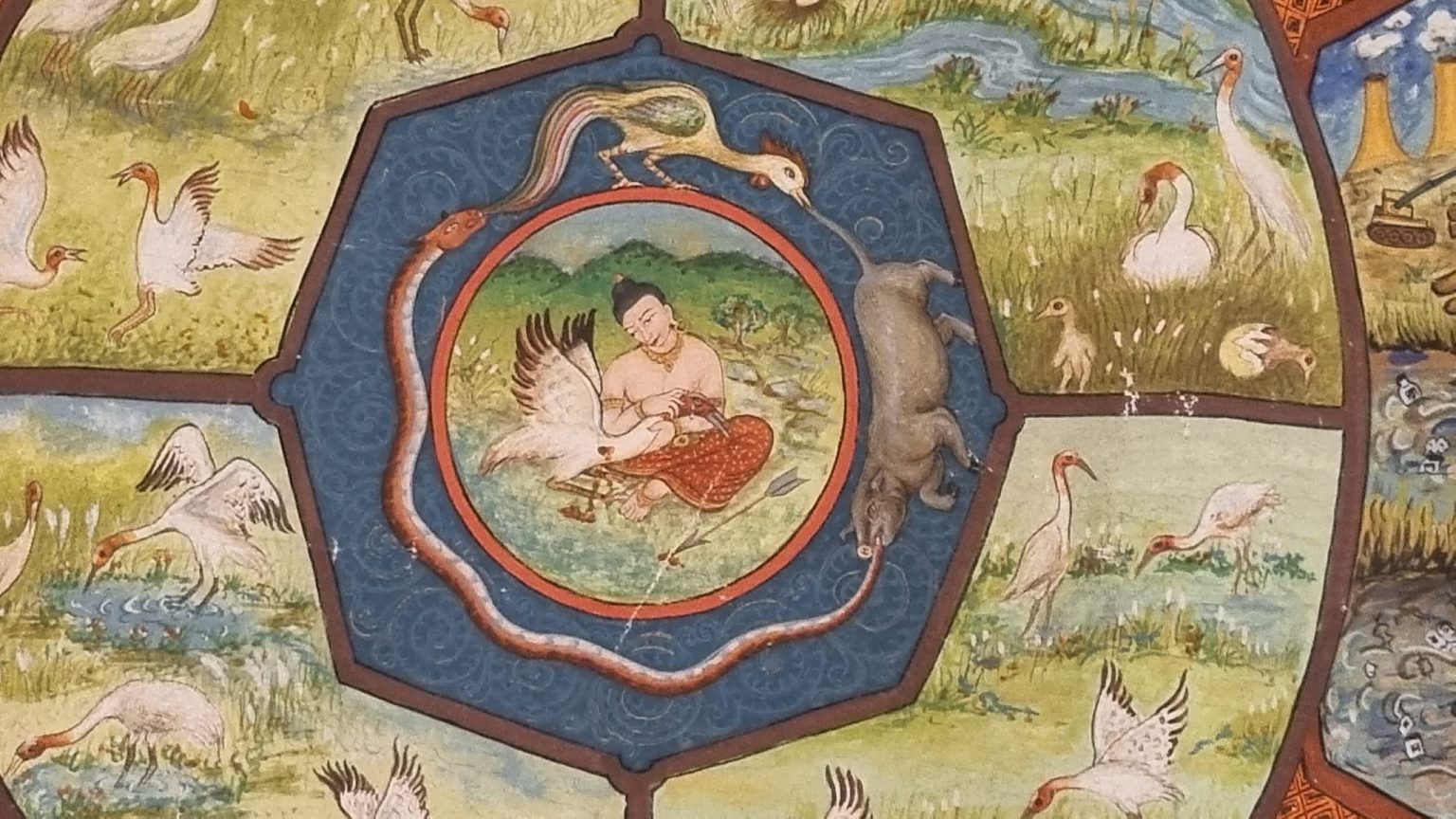
In Hinduism, the Valmiki-authored Ramayana also starts with the depiction of a loving pair of Saras (cranes) at the riverbank. A hunter shoots one of the cranes, causing it to be separated from its mate. Witnessing this event, a sage curses the hunter.
In Nepali society and culture, Saras symbolizes love and dedication. Saras forms a lifelong bond with its partner, and once a pair is formed, they stay together for life. “When one of the pair dies, the survivor never takes another mate. Thus, the symbol of Saras as a pair is considered an auspicious blessing for newlyweds, which is still a prevalent tradition in Nepali society. Additionally, the arrival of Saras in the Simsaar fields during the hot season is considered a sign of good health in the local beliefs.

What you know about sarus:
The word “Saras” is derived from the Sanskrit term “Saras” (crane). This omnivorous species feeds on plants (seeds and grains) and small animals (insects and amphibians). Its body is mostly light brown in color, with a red and white stripe on its neck and a pink beak.
In Nepal, there are nine protected bird species, and among them, four are Saras species. These include Saras, Karwankurung Saras, Laxman Saras, and Kali Kanth Saras. Karwankurung, Laxman, and Kali Kanth Saras are migratory birds. They come to Nepal from the northern hemisphere during the winter and stay in the southern parts, while some also remain here. Saras (Grus antigone) is considered Nepal’s native species. This species is sensitive (vulnerable) to environmental changes.
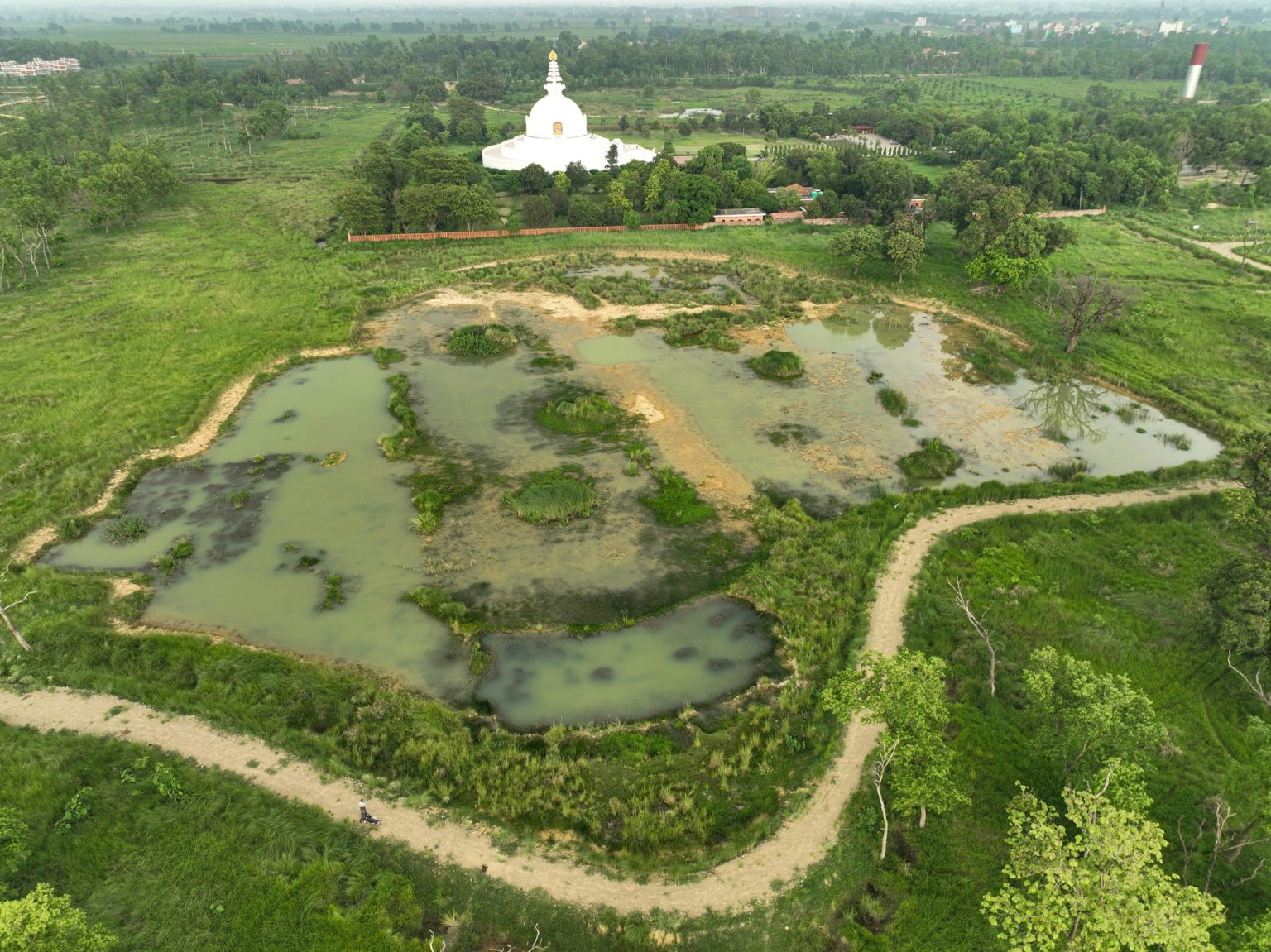
Among flying birds, Saras has the ability to fly at the highest altitude, ranging from 40 to 50 feet. The International Union for Conservation of Nature listed Saras as a rare species in the year 2000, with an adult weight of 10 kilograms and a height of up to 5 feet.-tourshala.com


